How to Configure Pharos Device, TP-Link’s free Pharos Control Software allows users to easily manage unlimited Pharos products for complete, unhindered network scalability. Batch management helps simultaneously configure and manage multiple devices, giving administrators an efficient, cost-effective and centralized management platform for an optimized network.
Take CPE as an example.
Access web management page of CPE
Please follow this link to access the web interface of CPE.
Note:CPE210 is a 2.4GHz device which can only broadcast 2.4GHz wireless network;CPE510 is a 5GHz device which can only broadcast 5GHz wireless network.Here we take CPE510 as example in this article.
Run Quick Setup
Step 1:
Go to Quick Setup-> Choose “Access Point” –> Click Next
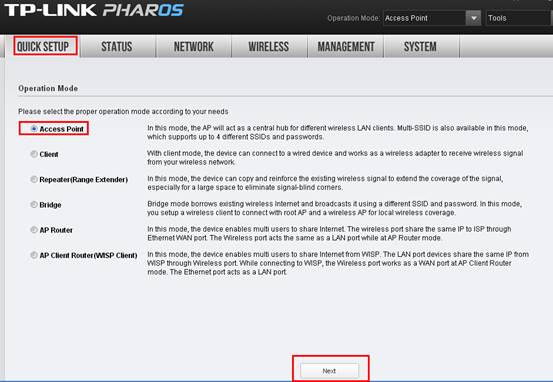
Step 2:
The default IP Address of CPE is 192.168.0.254,we can change it to other IP addresses to fit in the main router’s network.For example,if the main modem/router’s IP Address is 192.168.1.1,we can set up the CPE510 as 192.168.1.* (*=2~254),Subnet Mask 255.255.255.0 .
It is also fine to leave it as the default value if you are not sure about the main router’s IP address,then click Next.

Step 3:
Customize your wireless name (SSID) and password
|
SSID: (Rename Your Wireless Name) Security: WPA-PSK/WPA2-PSK PSK Password: (Create a Private Password) |
Step 4:
Click: Finish, and wait for the settings to take effect, it takes about 1 minute.
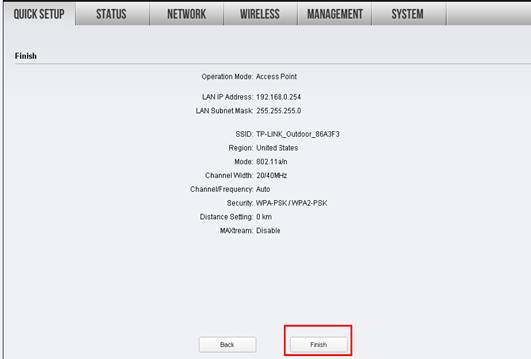
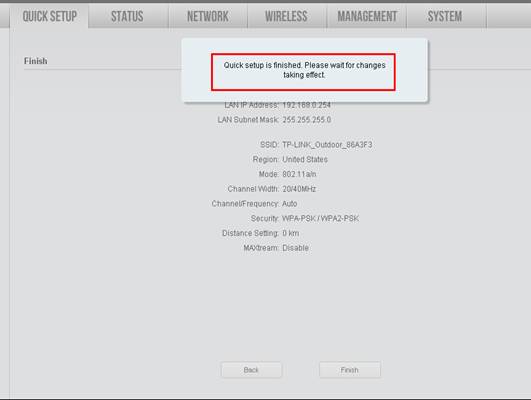
Relocate the CPE
You may now unplug the computer from the LAN port of the PoE adapter,and connect the wired network(internet modem/router) into the LAN port.
Final Computer Setup Reversion(For Windows OS)
We need change the IP settings back on the computer after the configuration.
Please find Local Area Connection/Ethernet on the computer, if you cannot remember the procedure, please refer to the FAQ again.
How to login to the Pharos’ web management page?
How to Configure Pharos Device
Read More : TP-Link Pharos Series Installation Guide
Go to Properties →Internet Protocol Version 4(TCP/IP)→ Select “Obtainan IP address automatically” and “Obtain DNS server address automatically”
Click OK to exit
Click OK again to apply the settings.
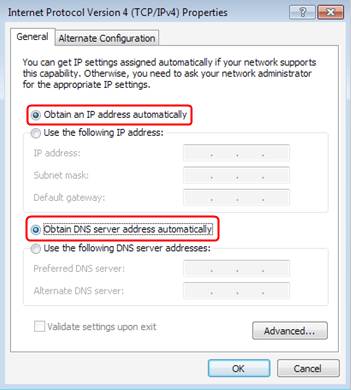
Final Computer Setup Reversion (For Mac OS X)
Go to the Apple->System Preferences->Network-> Highlight Ethernet –>Configure IPv4: Using DHCP.
Click Apply.
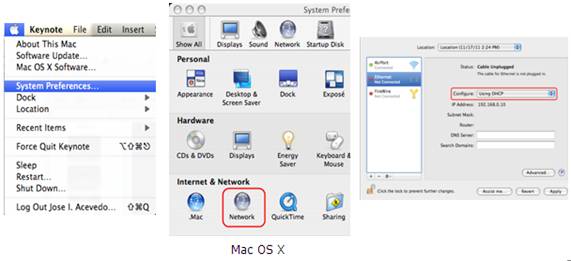
Get to know more details of each function and configuration please go to Download Center to download the manual of your product.
This guide introduces how to build a wireless network using the CPE/WBS products:
1. Check the System Requirements
2. Log In to the Device
3. Set Up the Wireless Network
The following parts detailedly introduces these steps.
1Check the System Requirements
Operating System:
Microsoft Windows XP, Windows Vista, Windows 7, Windows 8, Windows 10, Linux, or Mac OS X.
Google Chrome, Safari, Firefox, and Apple Safari. IE browsers are not recommended.
2Log In to the Device
Before configuring the device, you need to access the PharOS configuration interface. Follow the steps below:
1)Connect your PC to the device.
2)Set the IP address of your PC as static IP address on 192.168.0.X subnet (X ranges from 2 to 253, e.g.192.168.0.10)
Figure 2-1Specifying the IP Address

3)Launch a web browser on and enter the management IP address of the device (192.168.0.254 by default) in the address bar to load the login page of the PharOS configuration interface.
Figure 2-2Entering the Management IP Address
4)Use admin for both of User Name and Password. Select the appropriate language from the Language drop-down list. Read and agree the terms of use, then click Login.
Figure 2-3Loging In
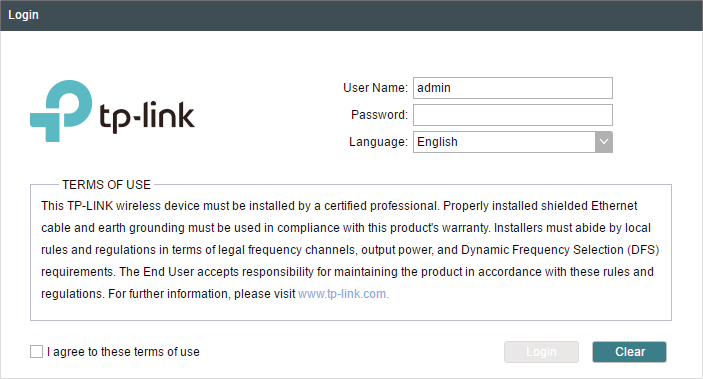
5)Create a new username and password for network security. Click Finish to log in to the PharOS.
Figure 2-4Creating a New Account
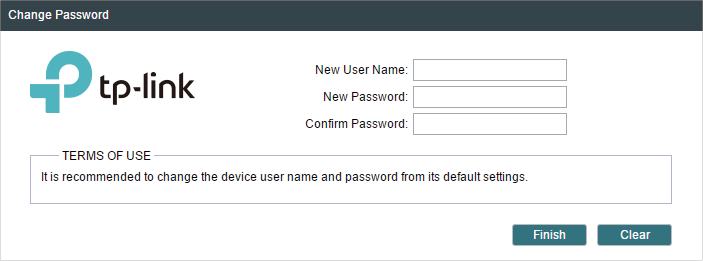
3Set Up the Wireless Network
You can use the Quick Setup wizard to quickly configure your device step by step. Choose the suitable operation mode according to your network environment and follow the step-by-step instructions.
3.1Access Point
Follow the steps below to configure the device as Access Point mode:
1)Go to the QUICK SETUP page, select Access Point and click Next.
Figure 3-1Selecting an Operation Mode
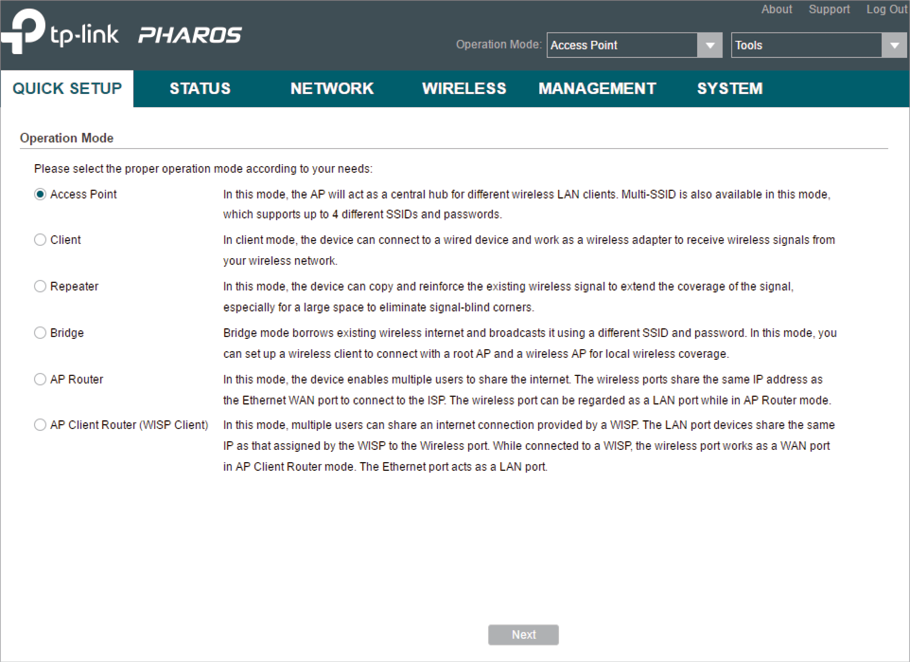
2)In the LAN Settings section, specify the LAN IP address and the Subnet Mask for the device. Then, click Next.
Figure 3-2Specifying the LAN Settings
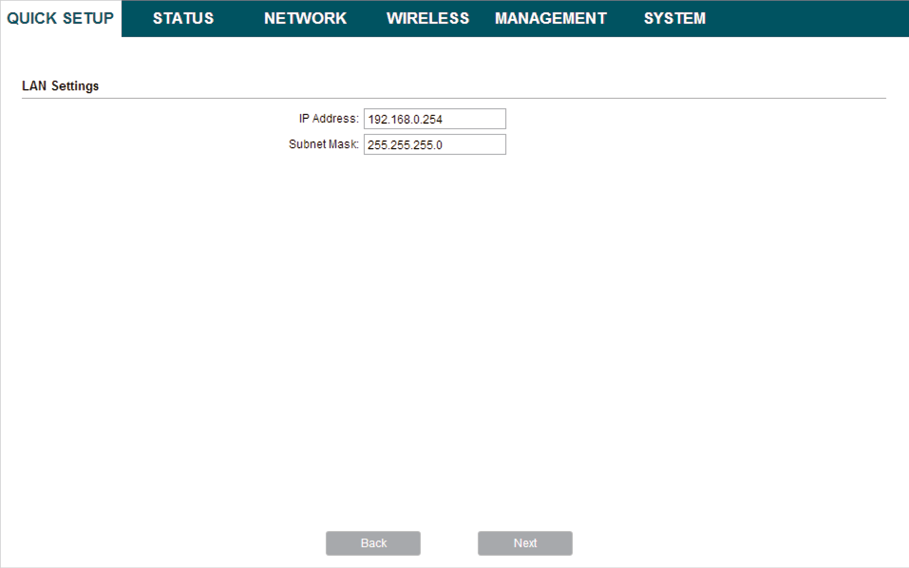
3)In the Wireless AP Settings section, specify the basic wireless parameters to create a wireless network. Click Next.
|
|
Note: It is recommended to specify Security as WPA-PSK/WPA2-PSK for the network security. You can keep the default settings or specify the parameters according to your need. For details, refer to Configure the Wireless Parameters. |
Figure 3-3Specifying the Wireless AP Settings
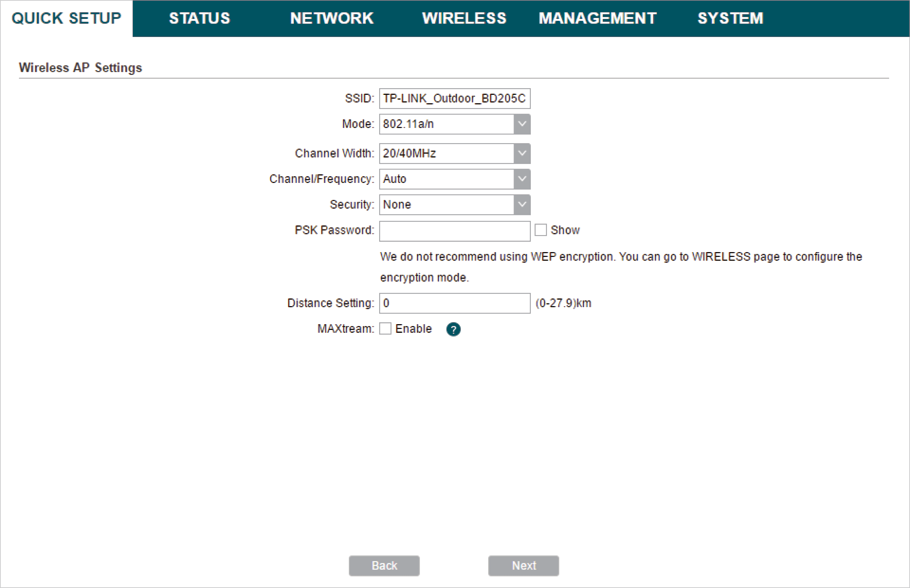
4)In the Finish section, review the configurations and click Finish to complete the quick setup.
Figure 3-4Checking the Settings

5)Connect the device according to your network topology and use it normally.
3.2Client
Follow the steps below to configure the device as Client mode:
1)Go to the QUICK SETUP page, select Client and click Next.
Figure 3-5Selecting an Operation Mode
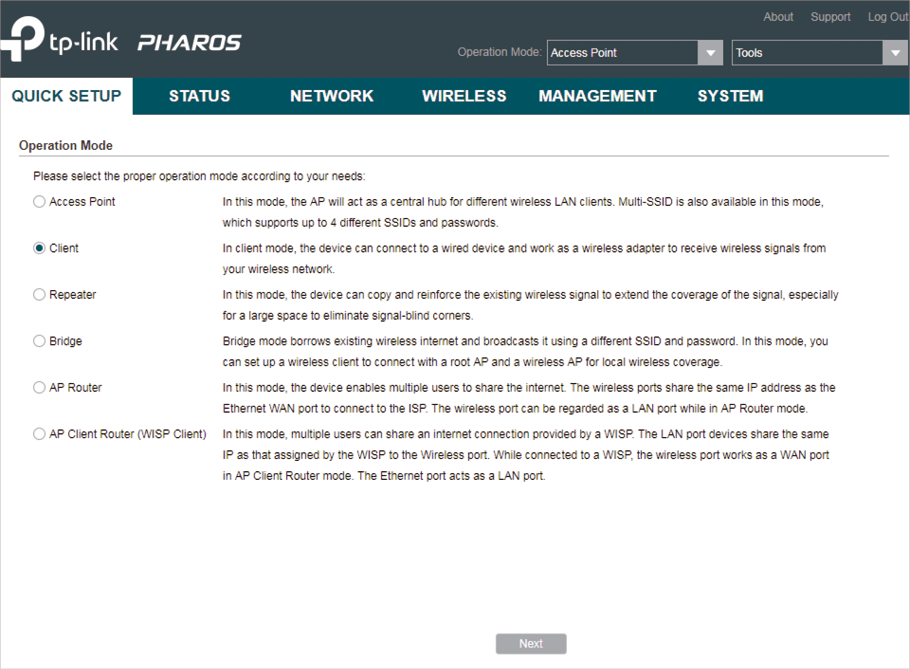
2)In the LAN Settings section, specify the LAN IP Address and the Subnet Mask for the device. Then, click Next.
Figure 3-6Specifying the LAN Settings
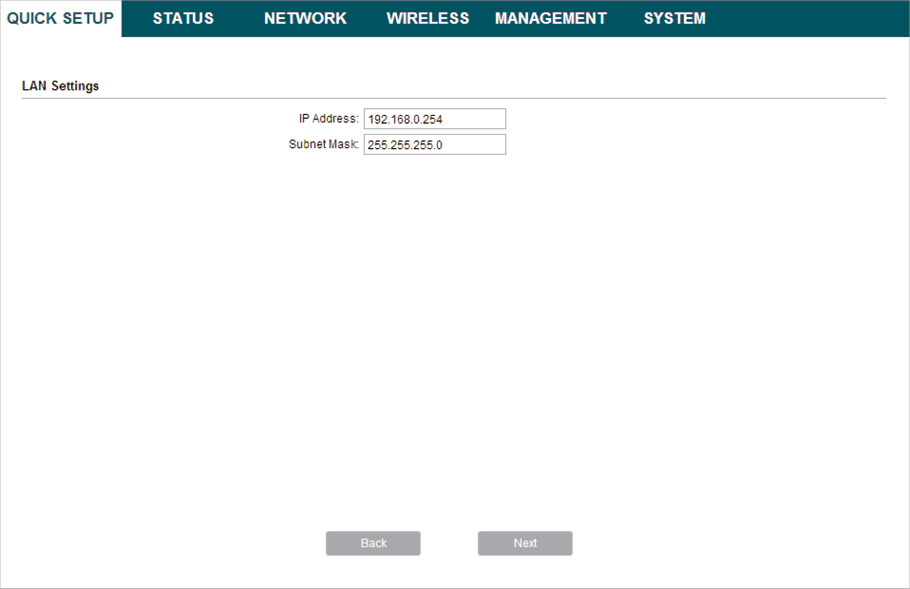
3)In the Wireless Client Settings section, click Survey to search for the upstream wireless network.
Figure 3-7Searching for Upstream Wireless Networks
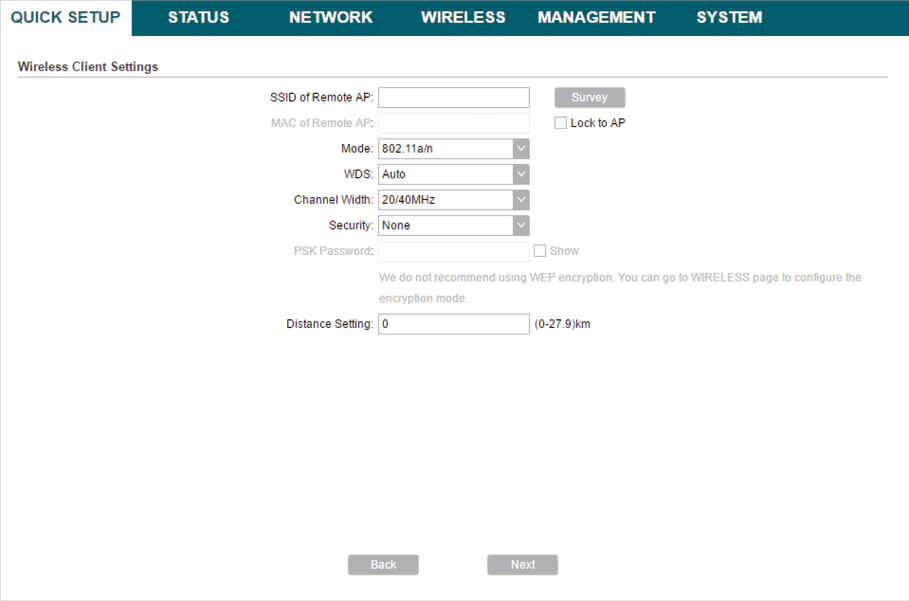
4)Select the desired wireless network and click Connect.
|
|
Note: There may be two or more networks with the same SSID in the AP list. Click Lock to AP to select the SSID and AP simultaneously, which can make the device connect to the specific AP next time. |
Figure 3-8Selecting an Upstream Wireless Network
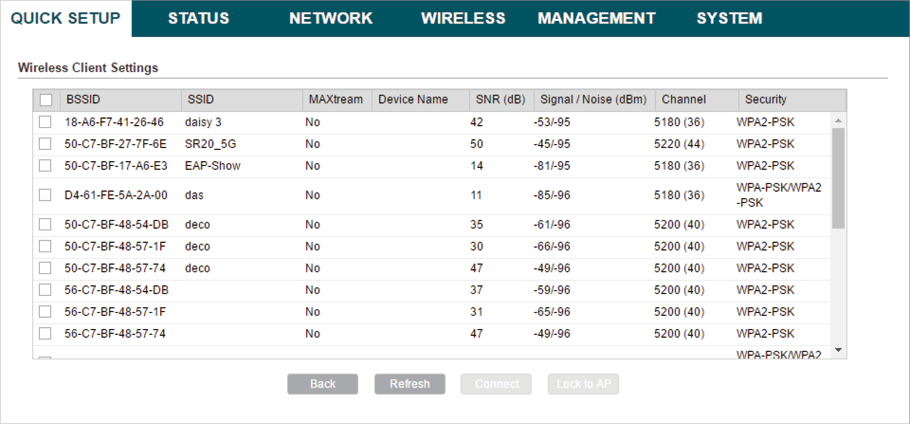
5)In the Wireless Client Settings section, specify the wireless parameters to connect to the specified wireless network. Click Next.
|
|
Note: Make sure that Security and PSK Password are the same as the upstream wireless network’s. Other parameters set in this page and those of the upstream wireless network should be compatible with each other. For details, refer to Configure the Wireless Parameters. |
Figure 3-9Specifying the Wireless Client Settings
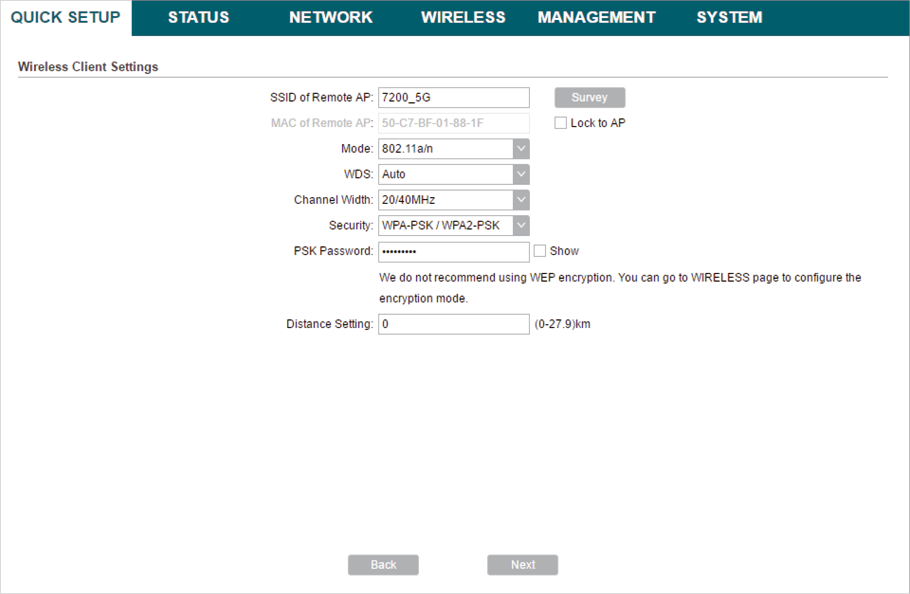
6)In the Finish section, review the configurations and click Finish to complete the quick setup.
Figure 3-10Checking the Settings
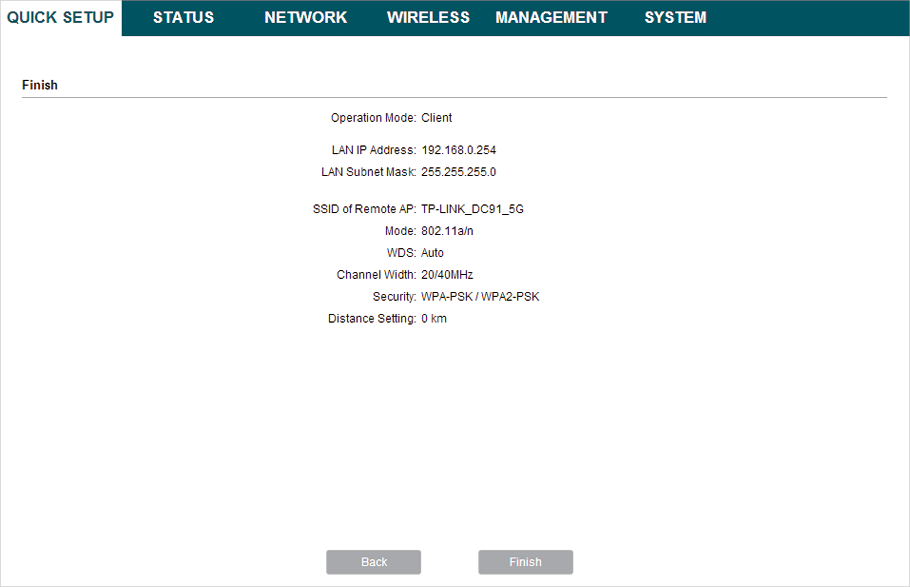
7)Connect the device according to your network topology and use it normally.
3.3Repeater (Range Extender)
Follow the steps below to configure the device as Repeater (Range Extender) mode:
1)Go to the QUICK SETUP page, select Repeater and click Next.
Figure 3-11Selecting an Operation Mode
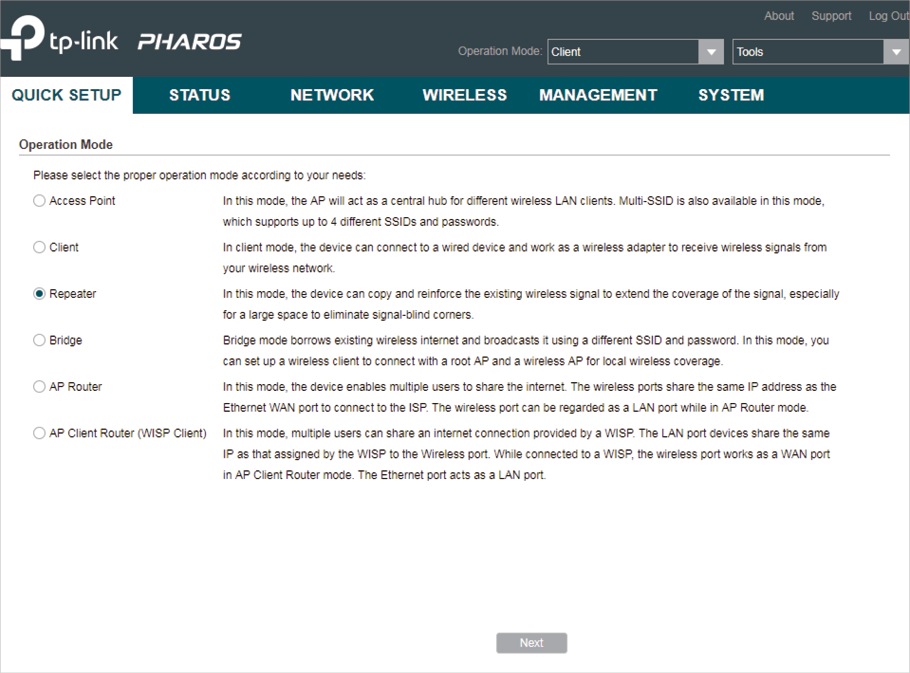
2)In the LAN Settings section, specify the LAN IP address and the Subnet Mask for the device. Then, click Next.
Figure 3-12Specifying the LAN Settings
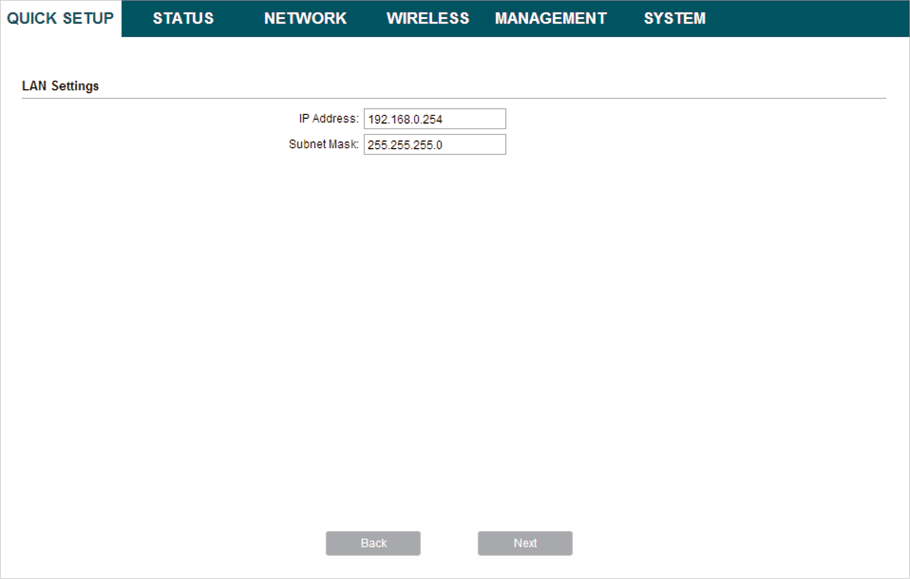
3)In the Wireless Client Settings section, click Survey to search for the upstream wireless network.
Figure 3-13Searching for Upstream Wireless Networks
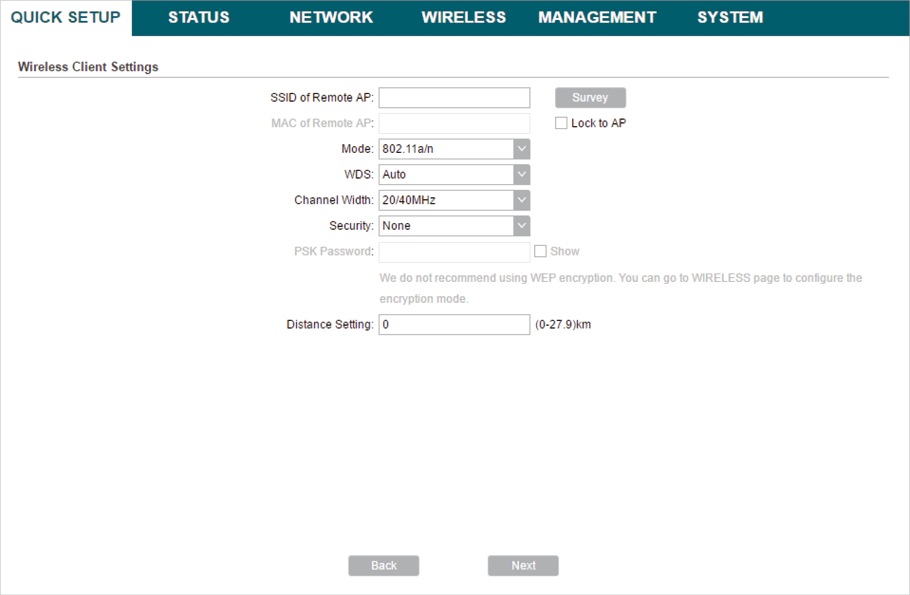
4)Select the desired wireless network and click Connect.
|
|
Note: There may be two or more networks with the same SSID in the AP list. Click Lock to AP to select the SSID and AP simultaneously, which can make the device connect to the specific AP next time. |
Figure 3-14Selecting an Upstream Wireless Network
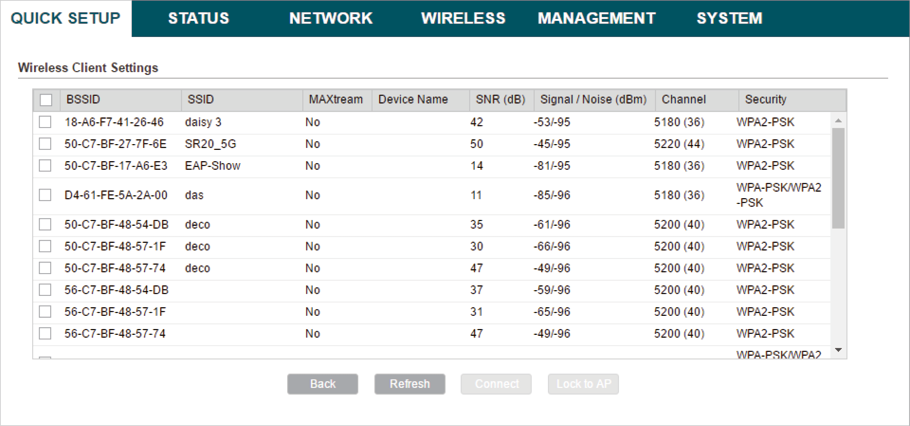
5)In the Wireless Client Settings section, specify the wireless parameters to connect to the specified wireless network. Click Next.
|
|
Note: Make sure that Security and PSK Password are the same as the upstream wireless network’s. Other parameters set in this page and those of the upstream wireless network should be compatible with each other. For details, refer to Configure the Wireless Parameters. |
Figure 3-15Specifying the Wireless Client Settings
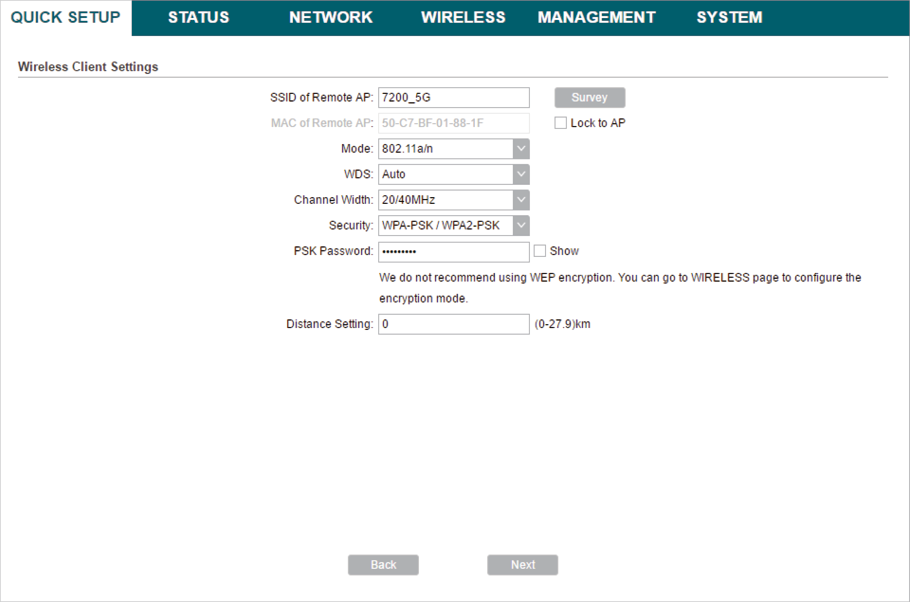
6)In the Finish section, review the configurations and click Finish to complete the quick setup.
Figure 3-16Checking the Settings
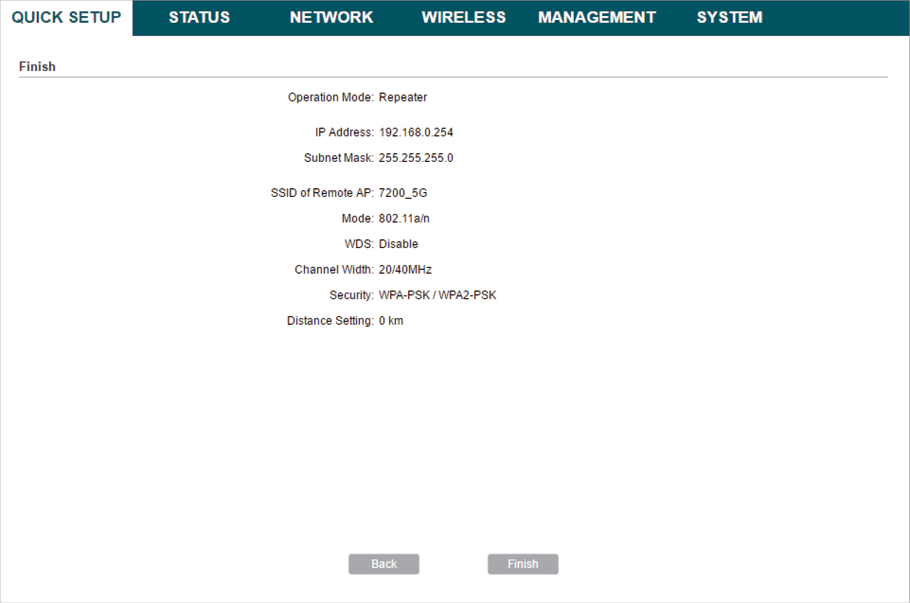
7)Connect the device according to your network topology and use it normally.
3.4Bridge
Follow the steps below to configure the device as Bridge mode:
1)Go to the QUICK SETUP page, select Bridge and click Next.
Figure 3-17Selecting an Operation Mode
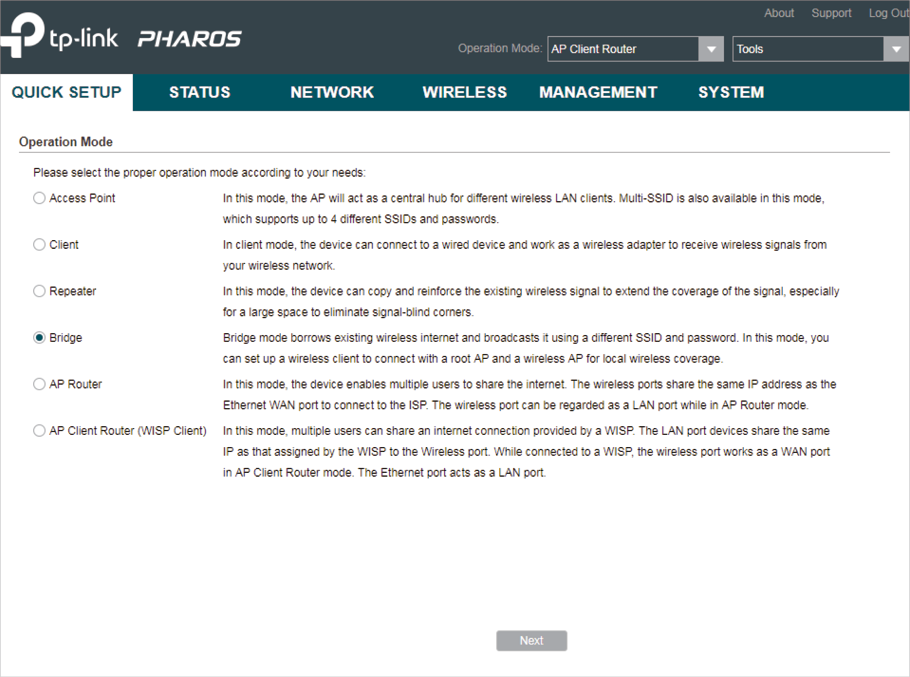
2)In the LAN Settings section, specify the LAN IP address and the Subnet Mask for the device. Then, click Next.
Figure 3-18Specifying the LAN Settings
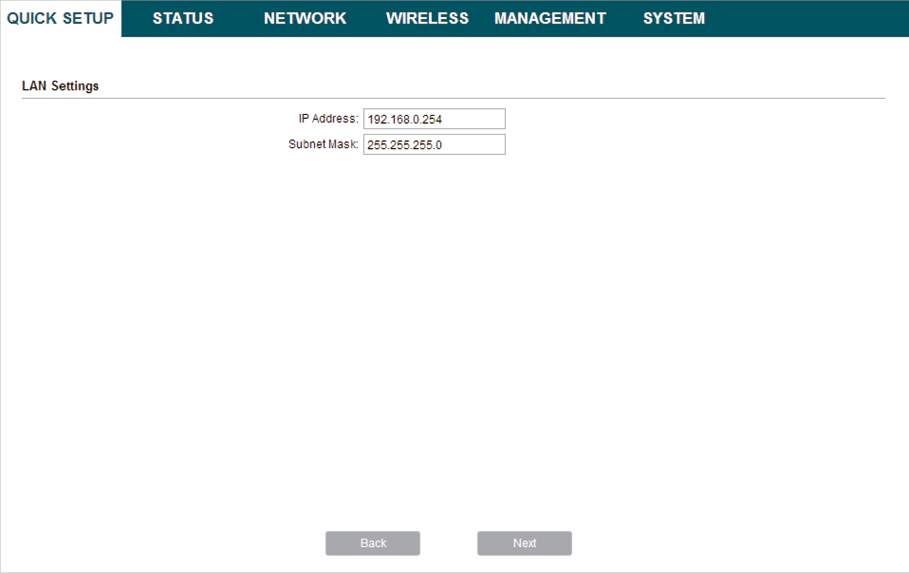
3)In the Wireless Client Settings section, click Survey to search for the upstream wireless network.
Figure 3-19Searching for Upstream Wireless Networks
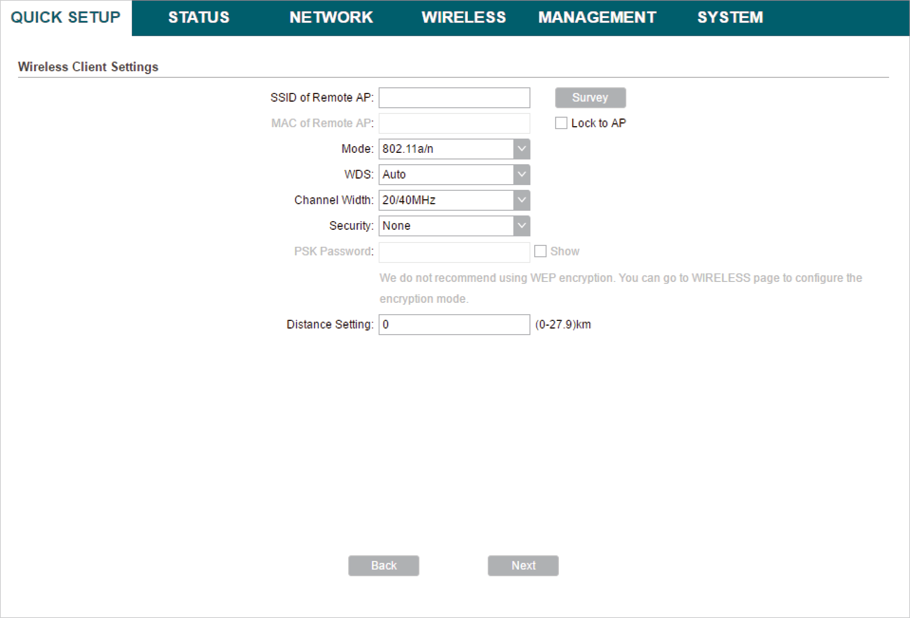
4)Select the desired wireless network and click Connect.
|
|
Note: There may be two or more networks with the same SSID in the AP list. Click Lock to AP to select the SSID and AP simultaneously, which can make the device connect to the specific AP next time. |
Figure 3-20Selecting an Upstream Wireless Network
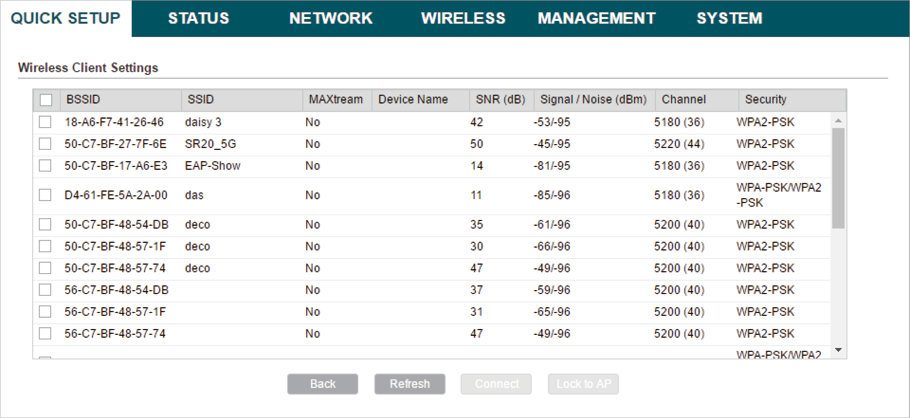
5)In the Wireless Client Settings section, specify the wireless parameters to connect to the specified wireless network. Click Next.
|
|
Note: Make sure that the Security and PSK Password are the same as the upstream wireless network’s. Other parameters set in this page and those of the upstream wireless network should be compatible with each other. For details, refer to Configure the Wireless Parameters. |
Figure 3-21Specifying the Wireless Client Settings
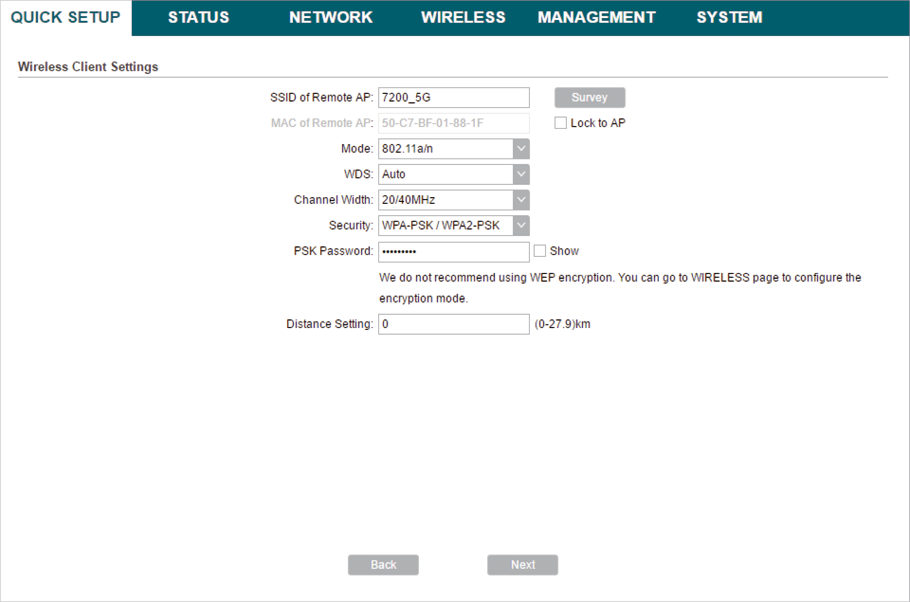
6)In the Wireless AP Settings section, specify the parameters to create a new wireless network for the downstream clients. Click Next.
Figure 3-22Specifying the Wireless AP Settings
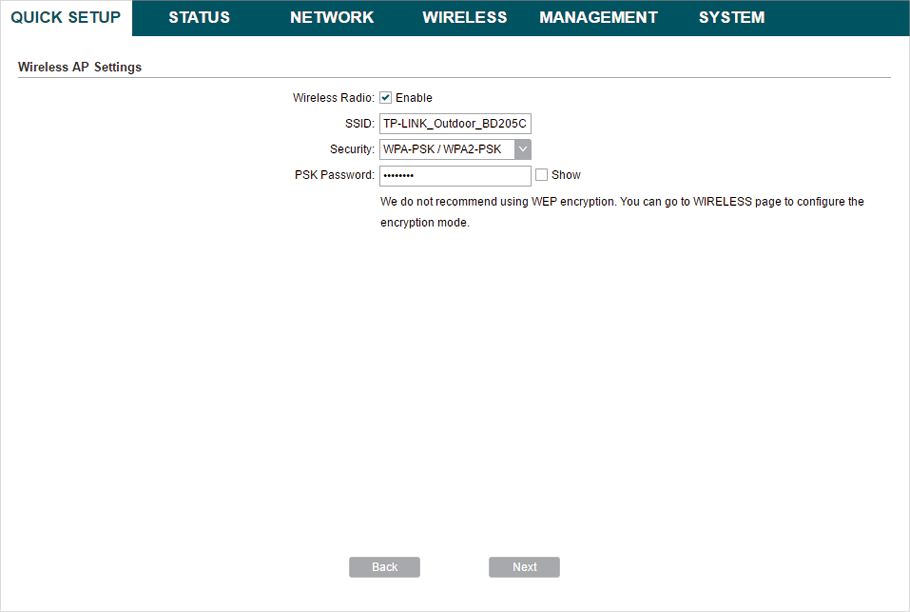
7)In the Finish section, review the configurations and click Finish to complete the quick setup.
Figure 3-23Checking the Settings

8)Connect the device according to your network topology and use it normally.
3.5AP Router
Follow the steps below to configure the device as AP Router mode:
1)Go to the QUICK SETUP page, select AP Router and click Next.
Figure 3-24Selecting an Operation Mode
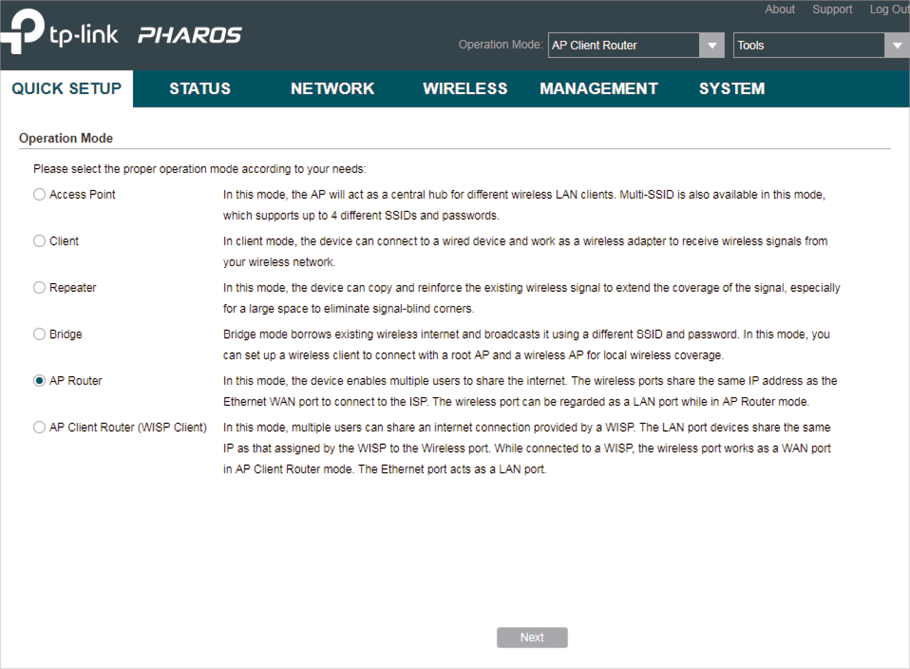
2)In the WAN Connection Type section, specify the connection type according to your need and click Next.
Figure 3-25Specifying the WAN Connection Type
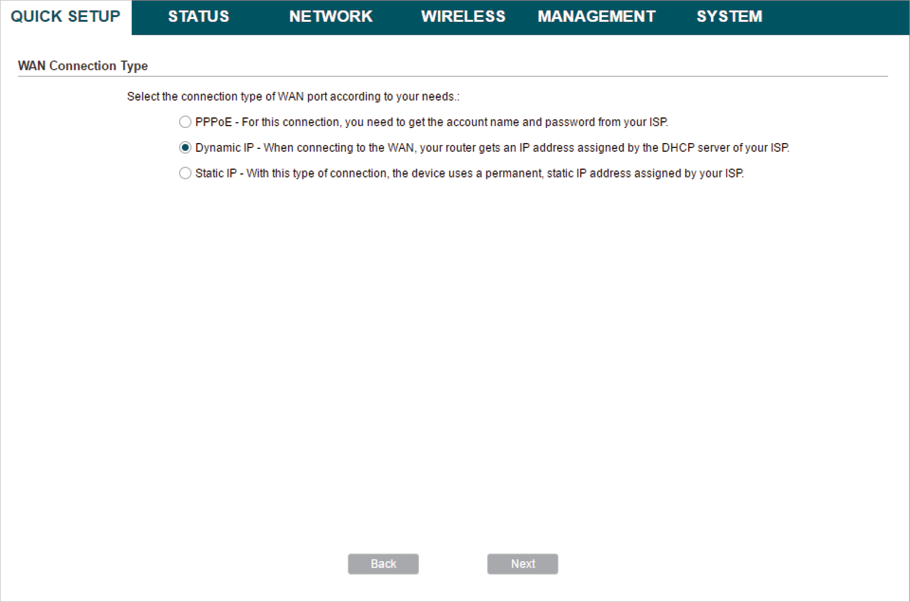
The device supports three types of the WAN connection, including PPPoE, Dynamic IP and Static IP. You can contact with your ISP to confirm your WAN connection type.
»PPPoE
Select PPPoE and click Next, then the following page will appear. In the WAN Settings section, specify the parameters that are provided by your ISP and click Next.
Figure 3-26Specifying the WAN Settings
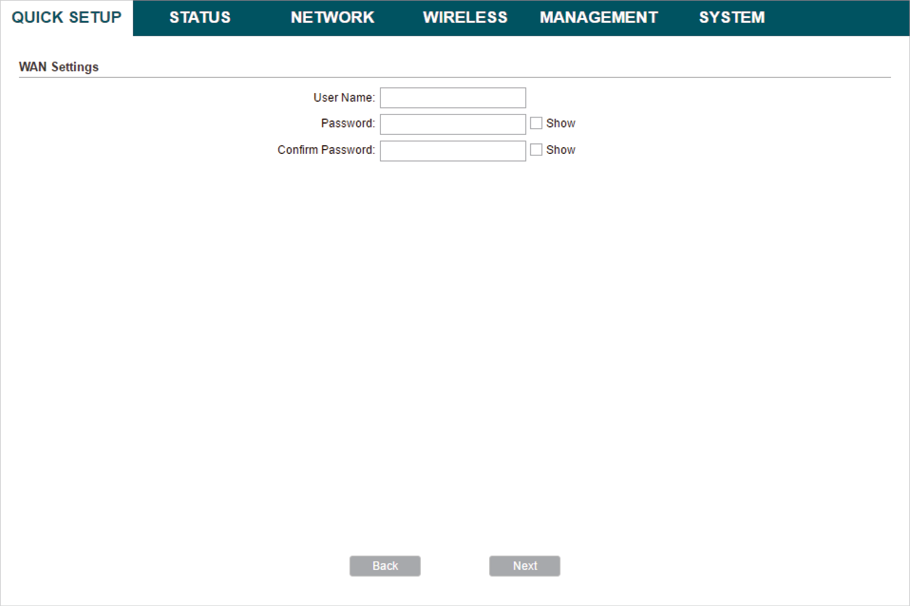
»Dynamic IP
Select Dynamic IP and click Next. In this type, the device will obtain a WAN connection automatically without any WAN configurations.
»Static IP
Select Static IP and click Next, then the following page will appear. In the WAN Settings section, specify the parameters that are provided by your ISP and click Next.
Figure 3-27Specifying the WAN Settings
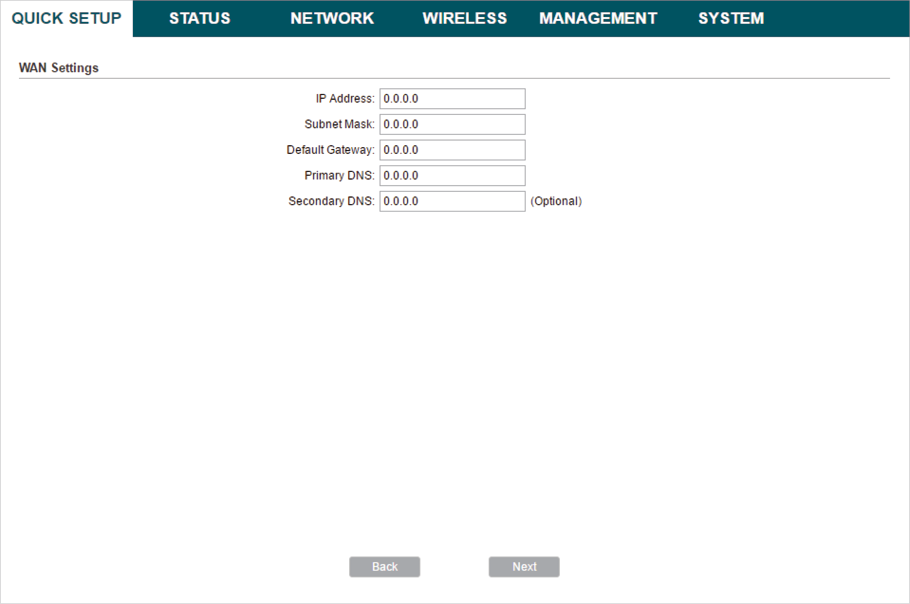
3)In the Wireless AP Settings section, specify the basic wireless parameters to create a wireless network. Click Next.
|
|
Note: It is recommended to specify Security as WPA-PSK/WPA2-PSK for the network security. You can keep the default settings or specify the parameters according to your need. For details, refer to Configure the Wireless Parameters. |
Figure 3-28Specifying the Wireless AP Settings
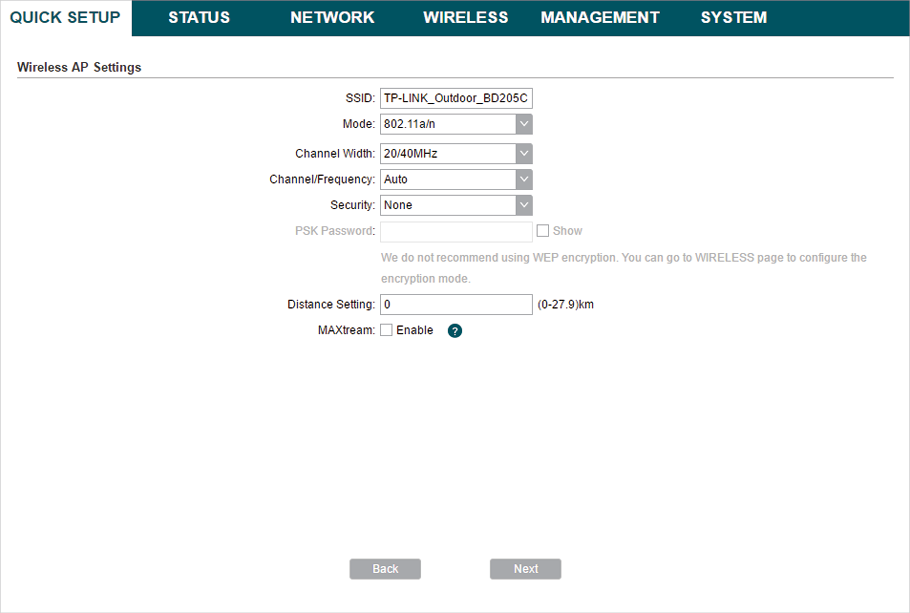
4)In the Finish section, review the configurations and click Finish to complete the quick setup.
Figure 3-29Checking the Settings
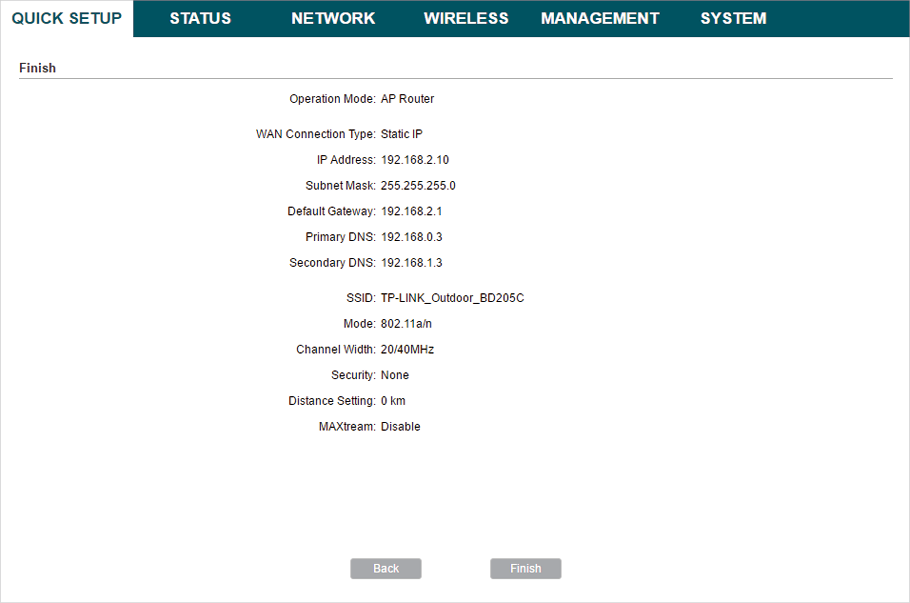
5)Connect the device according to your network topology and use it normally.
3.6AP Client Router (WISP Client)
Follow the steps below to configure the device as AP Client Router (WISP Client) mode:
1)Go to the QUICK SETUP page, select AP Client Router (WISP Client) and click Next.
Figure 3-30Selecting an Operation Mode
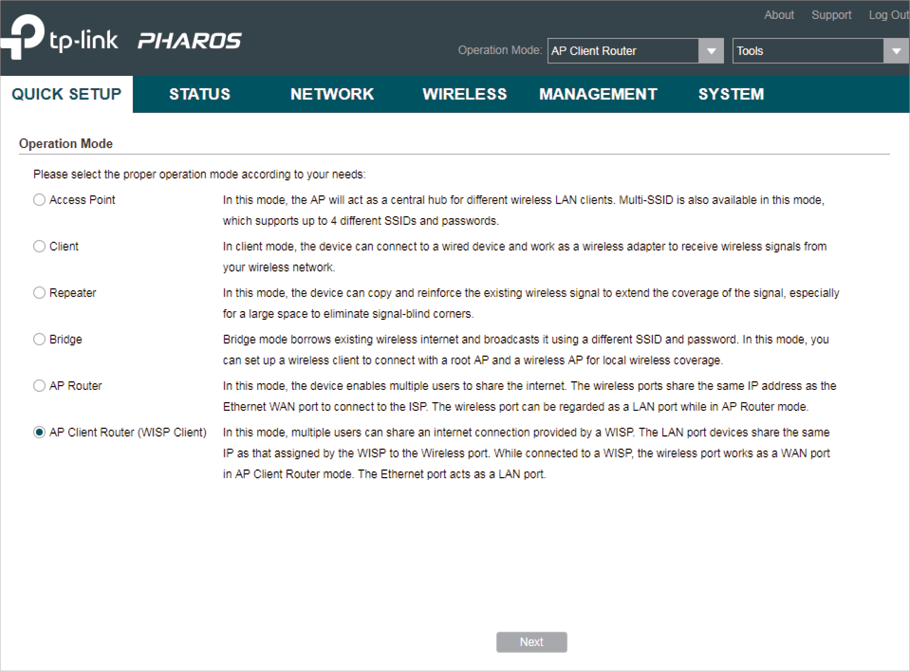
2)In the WAN Connection Type section, choose the connection type according to your need and click Next.
Figure 3-31Specifying the WAN Connecting Type
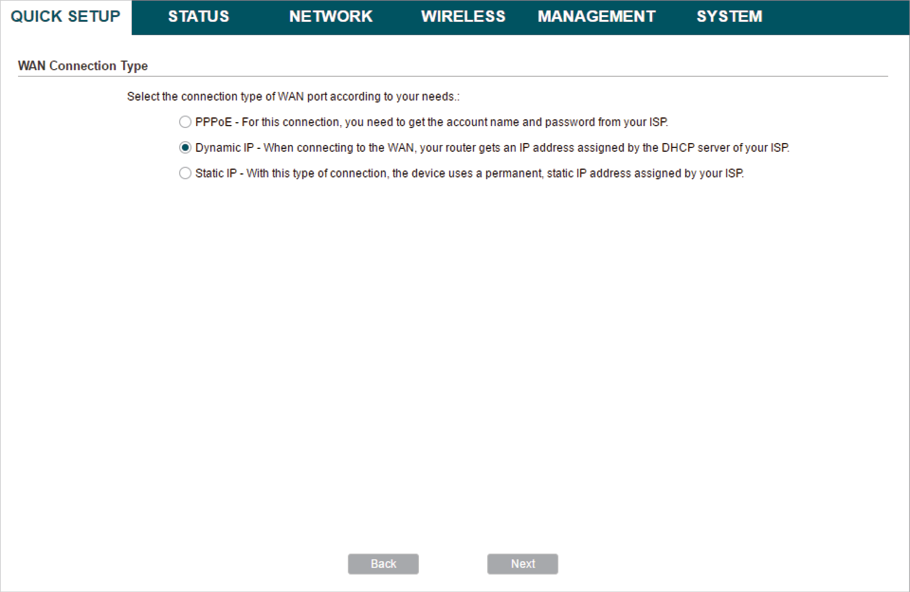
The device supports types, PPPoE, Dynamic IP and Static IP for the WAN connection. You can contact with your ISP to confirm your WAN connection type.
»PPPoE
Select PPPoE and click Next, then the following page will appear. In the WAN Settings section, specify the parameters that are provided by your ISP and click Next.
Figure 3-32Specifying the WAN Settings
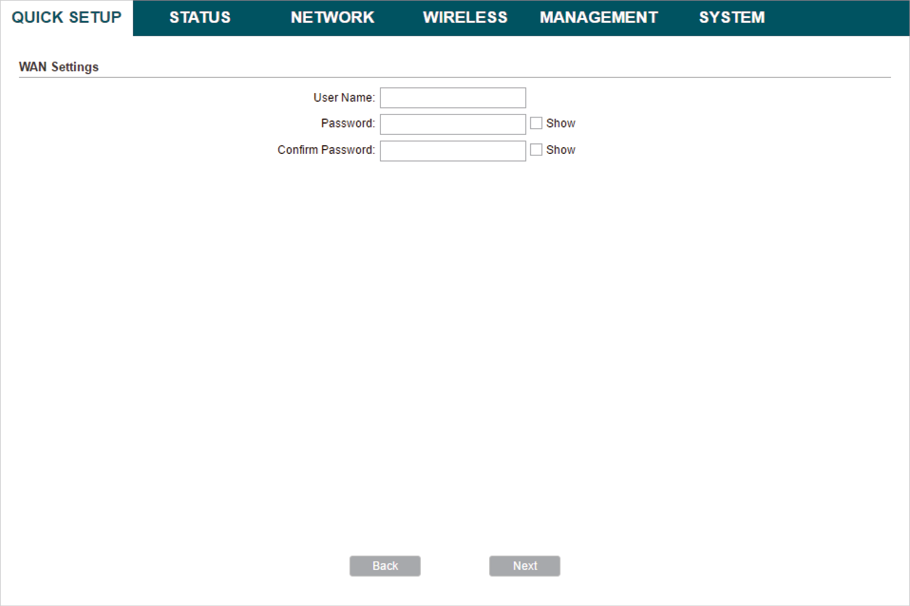
»Dynamic IP
Select Dynamic IP and click Next. In this type, the device will obtain a WAN connection automatically without any WAN configurations.
»Static IP
Select Static IP and click Next, then the following page will appear. In the WAN Settings section, specify the parameters that are provided by your ISP and click Next.
Figure 3-33Specifying the WAN Settings
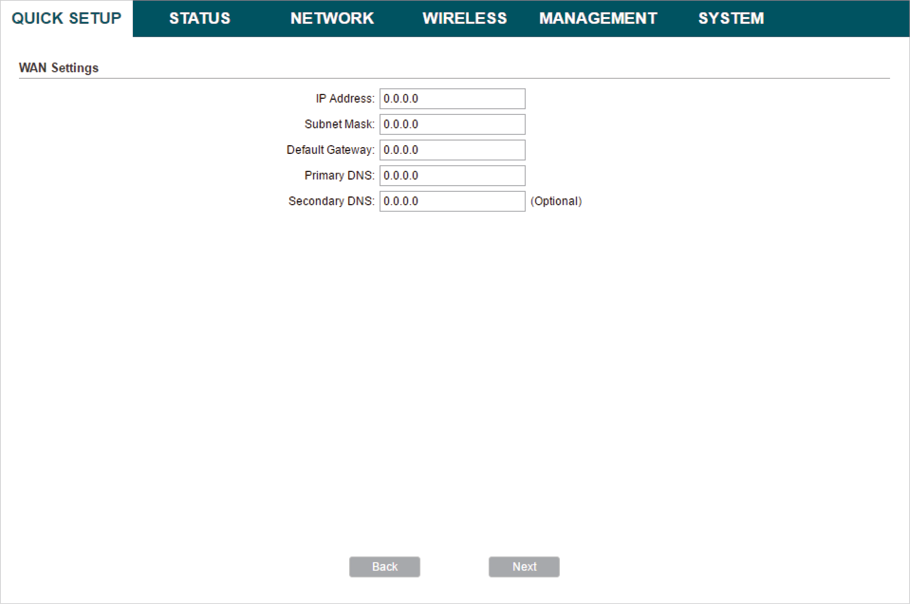
3)In the Wireless Client Settings section, click Survey to search for the upstream wireless network.
Figure 3-34Searching for Upstream Wireless Networks
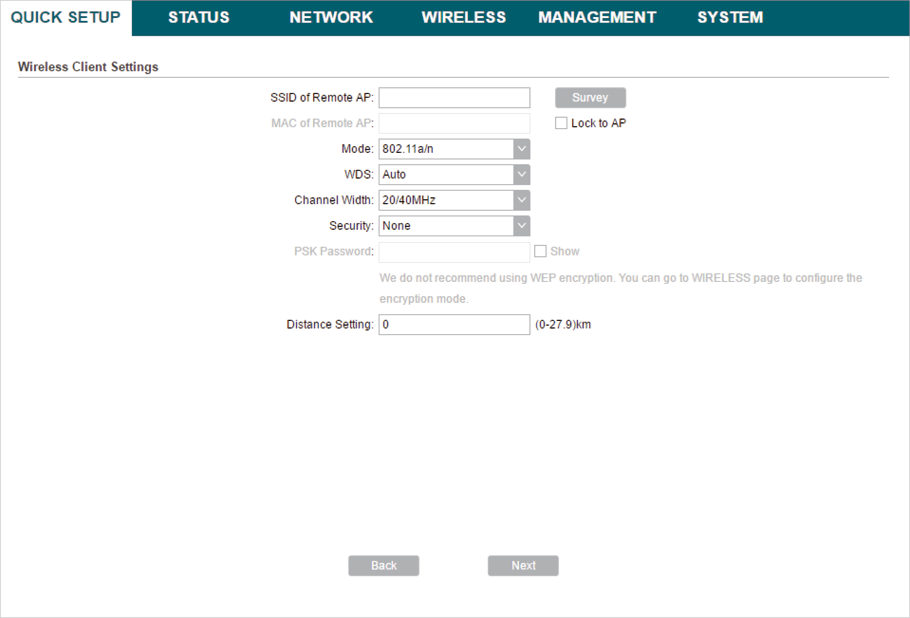
4)Select the desired wireless network and click Connect.
|
|
Note: There may be two or more networks with the same SSID in the AP list. Click Lock to AP to select the SSID and AP simultaneously, which can make the device connect to the specific AP next time. |
Figure 3-35Selecting an Upstream Wireless Network
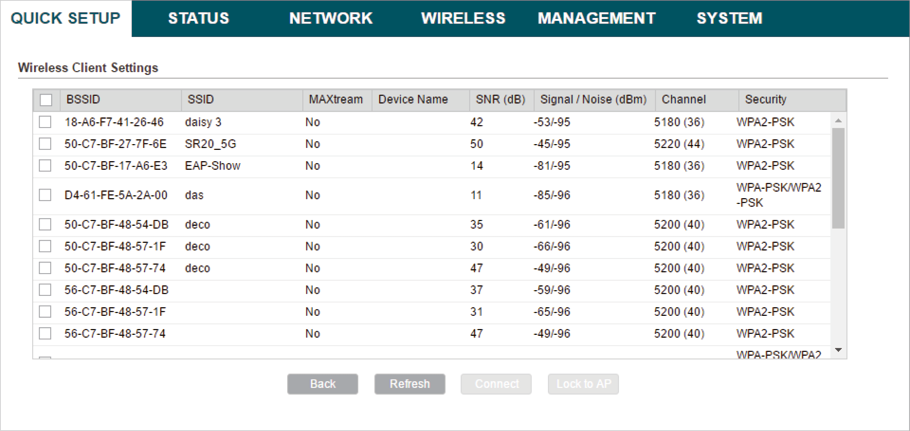
5)In the Wireless Client Settings section, specify the wireless parameters to connect to the specified wireless network. Click Next.
|
|
Note: Make sure that Security and PSK Password are the same as the upstream wireless network’s. Other parameters set in this page and those of the upstream wireless network should be compatible with each other. For details, refer to Configure the Wireless Parameters. |
Figure 3-36Specifying the Wireless Client Settings
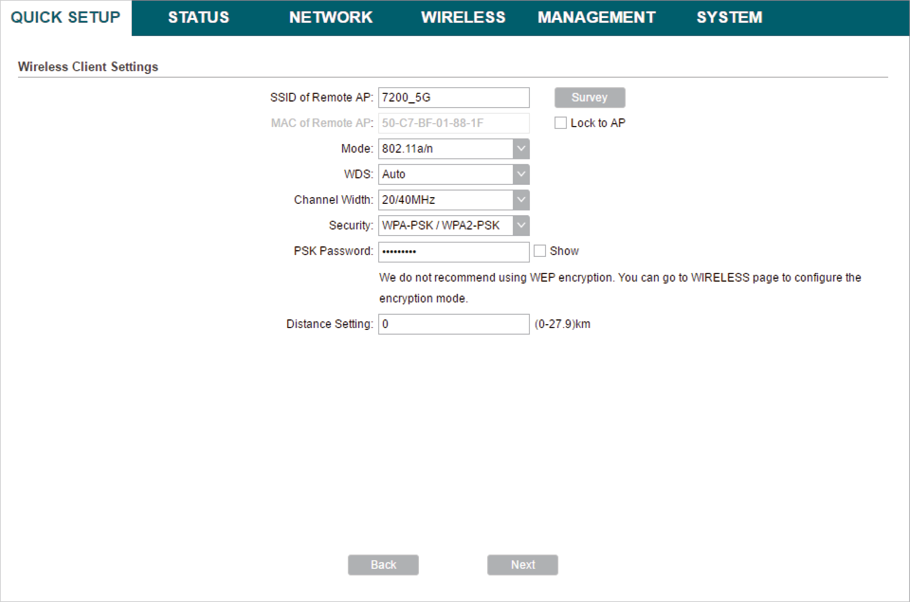
6)In the Wireless AP Settings section, specify the parameters to create a new wireless network for the downstream clients. Click Next.
Figure 3-37Specifying the Wireless AP Settings
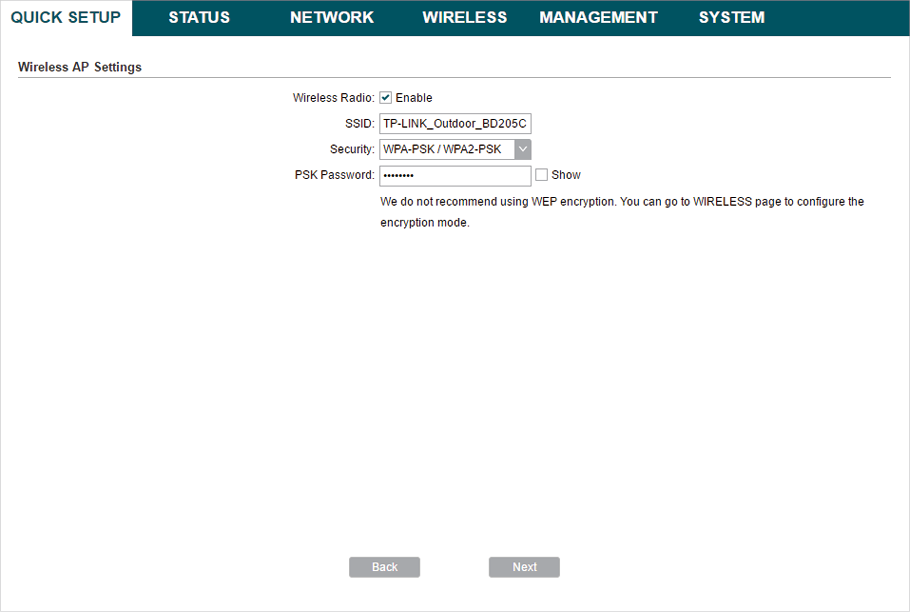
7)In the Finish section, review the configurations and click Finish to complete the quick setup.
Figure 3-38Checking the Settings
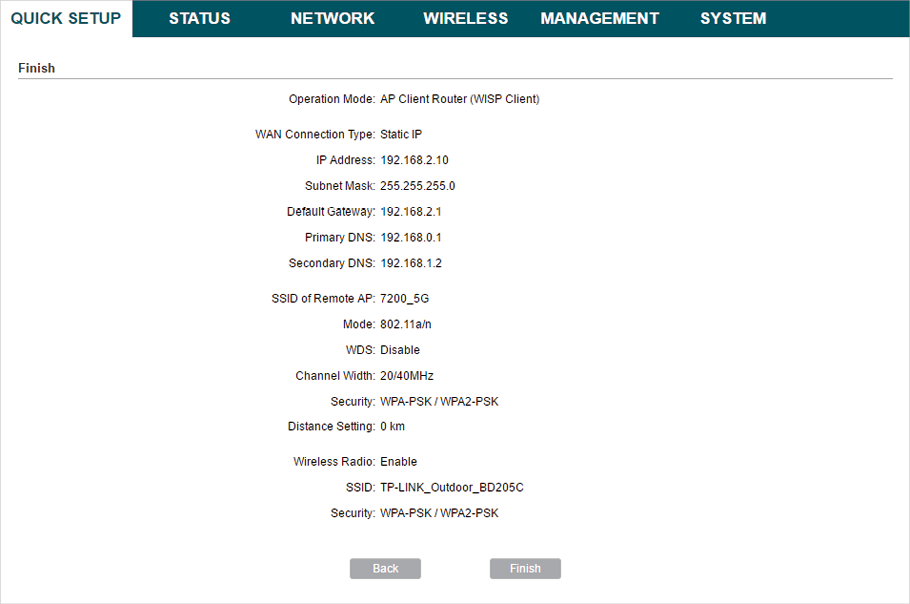
8)Connect the device according to your network topology and use it normally.
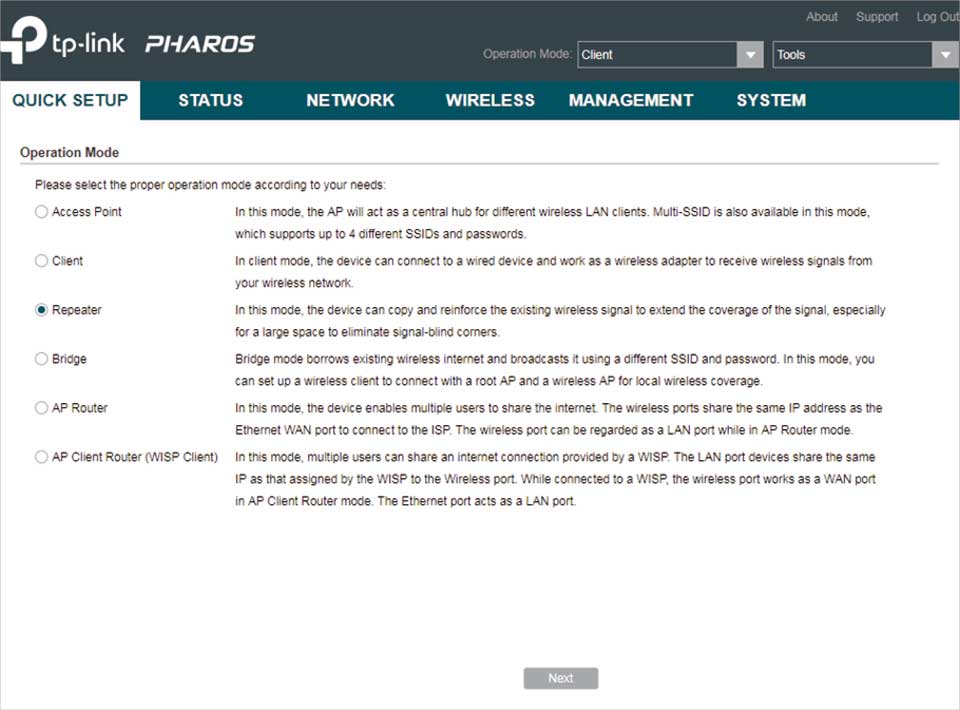
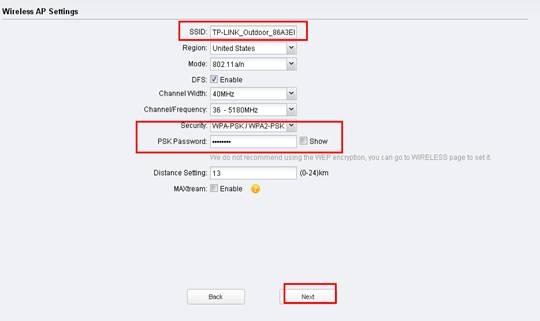

very informative post